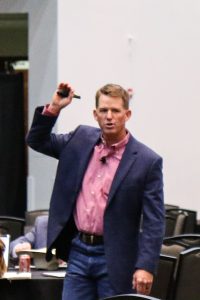
Locke says raising cattle is different than running a business that raises cattle.
“If you always think what you’ve always thought, then you will most likely get what you’ve always got, and most likely, you will fall behind; you will fail,” says John Locke, a Ranching for Profit (RFP) instructor.
For instance, Locke wonders, “What if our biggest paradigm in agriculture is that production and efficiency are the most important factors that determine profitability? And, what if that paradigm is wrong?”
Locke shared insights about managing for ranch profitability during the Young Producers Symposium during the 2021 Beef Improvement Federation (BIF) Symposium in Des Moines, Iowa, June 22.
Relatively few ranching operations are profitable if all costs are tallied, including labor. In fact, according to data from Ranch Management Consultants (RMC), industry average return on assets (ROA) is -1.5%. Among other things, RMC provides RFP instruction and training.
While profit should not be the sole focus of a ranching business, Locke notes profit is to business the same thing as breathing is to life. Business sustainability demands profitability.
“If we want a different result, we have to take different actions, and to take different actions, we need different paradigms,” Locke says.
That starts with considering how profitability is defined. Typically, when teams of RFP students develop a definition of profitability, Locke says it runs along the lines of: Income minus expenses equals profit.
“If you look at profit that way, you probably never will be profitable,” Locke says. The RFP definition of profit includes considering the ability to pay cash rent for the land, the full cost of labor and interest on all assets in production.
- “Whether you own or rent your land, if you have money left over at the end of the year and you haven’t paid rent on your land, then you’re saying, ‘My business can be profitable if I let my cows eat for free.’”
- “If you’ve got money left over at the end of the year and Junior works for free and you’ve got two people with jobs in town supporting the ranch, and you’re not paying the full cost of labor, you’re saying, ‘My ranch is profitable if I can always depend on free help.’”
- “Can you pay interest on all assets used in production, such as cows, equipment and machinery,” Locke asks. “If you’re not charging yourself an opportunity cost for those things, then what you’re saying is: ‘My ranch can be profitable if I let it use all of my money for free.’”
Keep in mind, Locke is CEO of the Locke Division of JD Hudgins Inc., a storied Brahman seedstock program that began in 1908.
Think back to that industry average ROA of -1.5%. It’s +4.2% for members of the RFP Executive Link program. For the top 20% of operations in Executive Link, ROA is +9.7%.
“Ranching, in general, is not profitable, but these people prove it can be,” Locke says.
What separates Executive Link ranchers from others, according to Locke is that they spend more time working on the business and less time working in the business.
“A lot of us spend so much time making sure we’re doing things right that we never have time to consider whether or not we’re doing the right things,” Locke says.
He shares the Pareto Principle, which says 20% of actions create 80% of the results. Working on the business rather than in the business represents the crucial 20%.
“Knowing how to grow cops and raise livestock is not the same thing as knowing how to run a business that grows crops and raises livestock,” Locke says, echoing the foundation of RFP.
“Many of us didn’t learn how to work on the business, and it’s understandable, but it’s not acceptable because if we don’t learn how to work on the business, we’re never going to be able to learn how to build a sustainable business,” Locke explains.
To watch Locke’s full presentation, visit https://youtu.be/Orp9w-cupGg. For more information about this year’s Symposium and the Beef Improvement Federation, including additional presentations and award winners, visit BIFSymposium.com.
